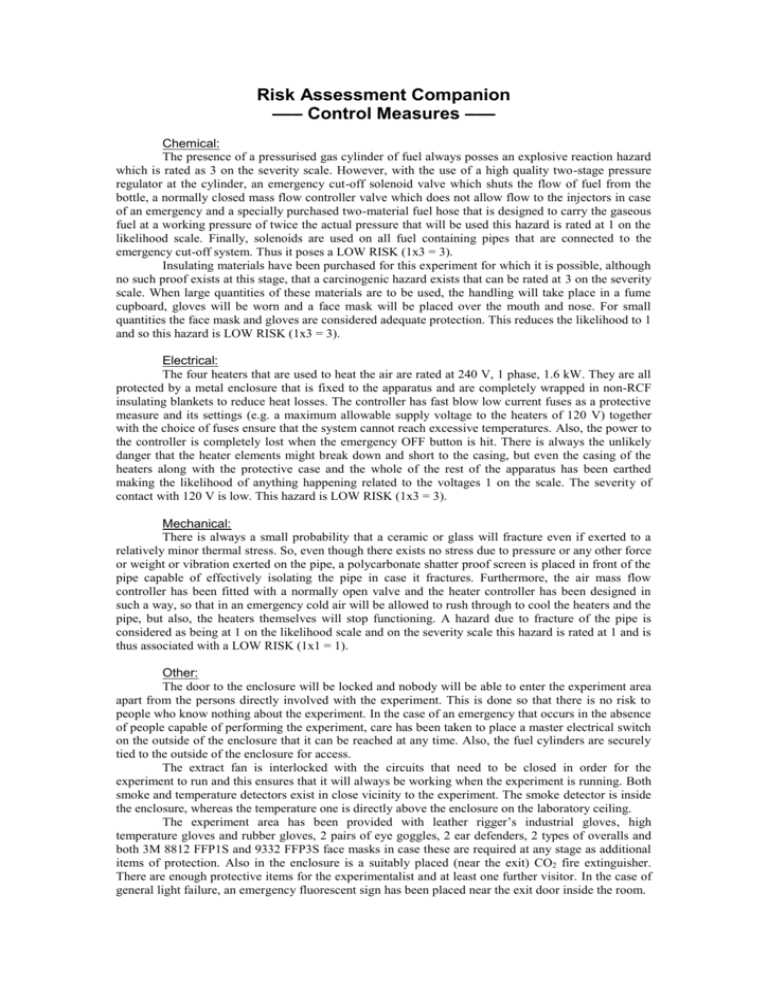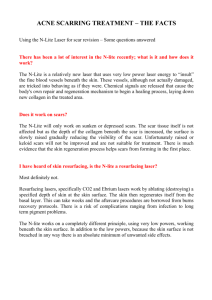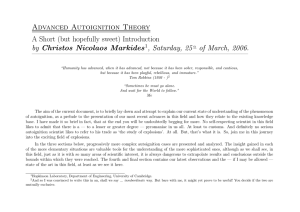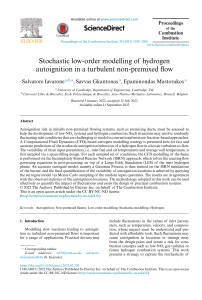Control Measures (2)
advertisement

Risk Assessment Companion ––– Control Measures ––– Chemical: The presence of a pressurised gas cylinder of fuel always posses an explosive reaction hazard which is rated as 3 on the severity scale. However, with the use of a high quality two-stage pressure regulator at the cylinder, an emergency cut-off solenoid valve which shuts the flow of fuel from the bottle, a normally closed mass flow controller valve which does not allow flow to the injectors in case of an emergency and a specially purchased two-material fuel hose that is designed to carry the gaseous fuel at a working pressure of twice the actual pressure that will be used this hazard is rated at 1 on the likelihood scale. Finally, solenoids are used on all fuel containing pipes that are connected to the emergency cut-off system. Thus it poses a LOW RISK (1x3 = 3). Insulating materials have been purchased for this experiment for which it is possible, although no such proof exists at this stage, that a carcinogenic hazard exists that can be rated at 3 on the severity scale. When large quantities of these materials are to be used, the handling will take place in a fume cupboard, gloves will be worn and a face mask will be placed over the mouth and nose. For small quantities the face mask and gloves are considered adequate protection. This reduces the likelihood to 1 and so this hazard is LOW RISK (1x3 = 3). Electrical: The four heaters that are used to heat the air are rated at 240 V, 1 phase, 1.6 kW. They are all protected by a metal enclosure that is fixed to the apparatus and are completely wrapped in non-RCF insulating blankets to reduce heat losses. The controller has fast blow low current fuses as a protective measure and its settings (e.g. a maximum allowable supply voltage to the heaters of 120 V) together with the choice of fuses ensure that the system cannot reach excessive temperatures. Also, the power to the controller is completely lost when the emergency OFF button is hit. There is always the unlikely danger that the heater elements might break down and short to the casing, but even the casing of the heaters along with the protective case and the whole of the rest of the apparatus has been earthed making the likelihood of anything happening related to the voltages 1 on the scale. The severity of contact with 120 V is low. This hazard is LOW RISK (1x3 = 3). Mechanical: There is always a small probability that a ceramic or glass will fracture even if exerted to a relatively minor thermal stress. So, even though there exists no stress due to pressure or any other force or weight or vibration exerted on the pipe, a polycarbonate shatter proof screen is placed in front of the pipe capable of effectively isolating the pipe in case it fractures. Furthermore, the air mass flow controller has been fitted with a normally open valve and the heater controller has been designed in such a way, so that in an emergency cold air will be allowed to rush through to cool the heaters and the pipe, but also, the heaters themselves will stop functioning. A hazard due to fracture of the pipe is considered as being at 1 on the likelihood scale and on the severity scale this hazard is rated at 1 and is thus associated with a LOW RISK (1x1 = 1). Other: The door to the enclosure will be locked and nobody will be able to enter the experiment area apart from the persons directly involved with the experiment. This is done so that there is no risk to people who know nothing about the experiment. In the case of an emergency that occurs in the absence of people capable of performing the experiment, care has been taken to place a master electrical switch on the outside of the enclosure that it can be reached at any time. Also, the fuel cylinders are securely tied to the outside of the enclosure for access. The extract fan is interlocked with the circuits that need to be closed in order for the experiment to run and this ensures that it will always be working when the experiment is running. Both smoke and temperature detectors exist in close vicinity to the experiment. The smoke detector is inside the enclosure, whereas the temperature one is directly above the enclosure on the laboratory ceiling. The experiment area has been provided with leather rigger’s industrial gloves, high temperature gloves and rubber gloves, 2 pairs of eye goggles, 2 ear defenders, 2 types of overalls and both 3M 8812 FFP1S and 9332 FFP3S face masks in case these are required at any stage as additional items of protection. Also in the enclosure is a suitably placed (near the exit) CO2 fire extinguisher. There are enough protective items for the experimentalist and at least one further visitor. In the case of general light failure, an emergency fluorescent sign has been placed near the exit door inside the room. Risk Assessment Companion ––– Laser Utilisation Procedures and Measures ––– As previously stated when the experiment is run simultaneously with the lasers, the experiment will effectively take place in two rooms: the Flame Rig/Turbulent Autoignition Cell and the adjacent Laser Room. The beam will be generated in the later and be turned into a sheet with use of a cylindrical lens. Fully enclosed along the entire length it will travel inside a metallic tube though a small (20 mm x 100 mm) slit made in the adjacent walls separating the two rooms. The slit will have black painted metallic widows on both sides that can be used to completely shut this opening and stop the beam from going through at any time. The end user will be situated in the Flame Rig/Turbulent Autoignition Cell and from there he will be able to fully control the Lasers in the Laser Room via the controlling PC. The Flame Rig/Turbulent Autoignition Cell, just like the Laser Room is equipped with a door sensor. In the case of the either door opening while the lasers are on, the power to the lasers will be cut. A further person (Laser Room Overseer mentioned in Part 3 of the Risk Assessment Form) will always be present in the laser room while the lasers are running, to make sure that there are no problems in the adjacent room. The end user can communicate with the Laser Room operator directly via hand-held radio receiver/transmitters situated in both rooms. Furthermore, visual messages and communication can be carried out through the PCs and by a light in the Laser Room that has been placed specifically for this purpose. It can be switched on and off from inside the Flame Rig/Turbulent Autoignition Cell in order to signify that the end user is getting ready for a run. The Flame Rig/Turbulent Autoignition Cell has been designed with Laser measurements in mind and many such measurements have been previously made in the early ‘90s. The wall and all tables and vast majority of other items are painted matt black and there are no windows in the 4 m high walls. Any holes for screws have been located and closed once more. The acetone tracer used in the experiment is the same that has already been used inside the Laser Room. It will not be kept in the Flame Rig/Turbulent Autoignition Cell but in the Heat Lab chemical cupboard, apart from the quantity in use. This should not be more than 200 ml at any time. Laser safety signs are available and will be posted outside the Flame Rig/Turbulent Autoignition Cell. Laser spectacles exist in the Laser Room for both users. All people relevant to these experiments are registered laser users and have had the required eye tests. All other hazards, risks and procedures as per Laser Room.










